TIB: Today I Bought (and Sold) - An Investors Journal #10 - Aegon Insurance, US Banks, Lithium and USD
The first day of 2017 that markets were open right across the world triggered a few pending trades and a few stop losses. There were a few surprises and a few nice wins.
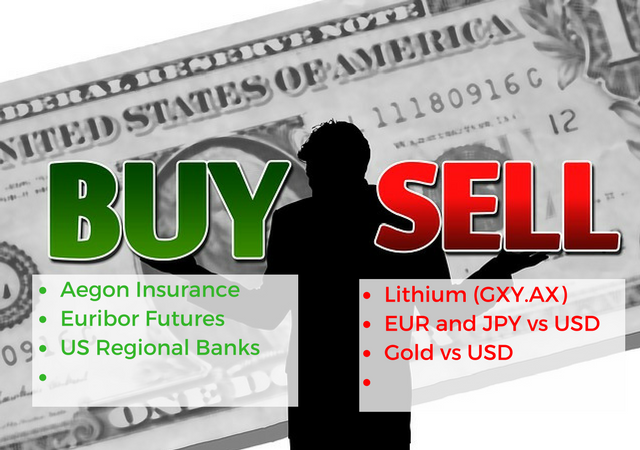
Bought
Aegon Insurance (AGN.AS): December 21 Call 7.2. First opportunity to buy 2021 call options [Means: the right to buy at a certain price (strike price)]. Premium was less than 10% and 4 years to get there. This is part of a process of building a staircase of call options at different strike prices. Current AGN price is just below the December 2020 5.6 calls I have.
Euribor 3 month interest rate futures (FEIM9) Sept 2018: I had been short a few contracts as I had seen European interest rates rising faster at the short end of the curve compared to the long end (June 2020). With low volume on January 2 trade (in Europe while US was closed) price of these futures spiked and took out my stop losses. I use stop losses on these futures contracts as the contracts are large (€250,000 each).
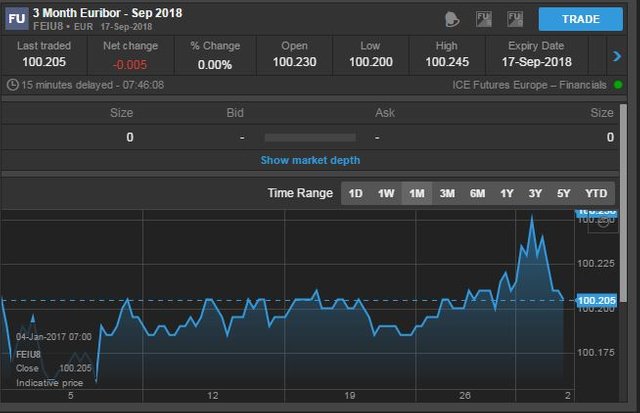
I had thought stop loses were in a safe place - above 3 month highs. This is a challenging part of investing - price spikes on low volume and then goes back to where it came from. Loss taken = move on. With options one is not hostage to short term price volatility - one just has to manage the time decay value of the option over time. I will revisit this trade idea and use options especially on my smaller portfolios.
Sold
ING (INGA.AS). Sold in the money call options [means: current price is above the strike prices]. Sold Dec 20 Call 10 for 145% profit since Feb 2016 and Dec 20 Call 12 for 168% profit since Jun 2016 - great examples of asymmetry. ING has long been one of my preferred investments for the European Banking recovery. In #7 of the series I talked about the relative values of ING to other European Banks - these sales are part of that process. Taking profits here and investing in other European banks - viz, Commerzbank (Germany) and Credit Suisse (Switzerland).
You can review the post here http://mymark.mx/TIB7
SPDR S&P Regional Banking ETF Sold Jan 18 Call 50 for 178% profit since Nov 2015. Rolled up to Jan 19 Call 60. Buying more time and taking some profits along the way. US Banks will keep tracking upwards as interest rates rise.
Galaxy Resources (GXY.AX) - sold half the holding - this is a 43% profit on the average price I have paid over the years since October 2009.
I have promised to write occasionally about some of the themes I am following and how I get the ideas - here is one. This is a story in 3 parts.
Part 1 Galaxy is a pure-play lithium business. The idea came in 2009 from a mining research newsletter I subscribe to. Galaxy was operating a lithium hard rock mining business in Western Australia and had plans to build a lithium carbonate plant (for batteries) in China. My thought at the time (no research really) was that the demand for lithium for batteries would rise dramatically and I bought a small parcel of shares. These are the words that looked interesting
Galaxy’s vision is to be the leading producer of lithium carbonate in Asia. Its Mt Cattlin Lithium Tantalum mine in Western Australia has the potential to be the second largest hard rock mine in the world. Galaxy’s proposed lithium carbonate plant has the potential to be the largest plant and most competitive cost producer in China
http://www.galaxyresources.com.au/Investor/GXY-QuarterlyActivitiesandCashflowReportMar09.pdf
The story has not really gone to plan. The lithium carbonate plant in China proved to be a lot more expensive than planned. Lithium price did not really move as planned. The extension and completion of the Mt Cattlin processing facility required more capital than planned. Galaxy also went on a buying spree buying Lithium One in Canada and the Sal de Vida lithium brine deposit in Argentina. The share price tanked - and I kept buying with the last tranche bought at A$0.08 per share in a capital raising (compared to $1.53 which is the price I paid for the first tranche).
The chart shows the purchases as red arrows and the sales as blue arrows.
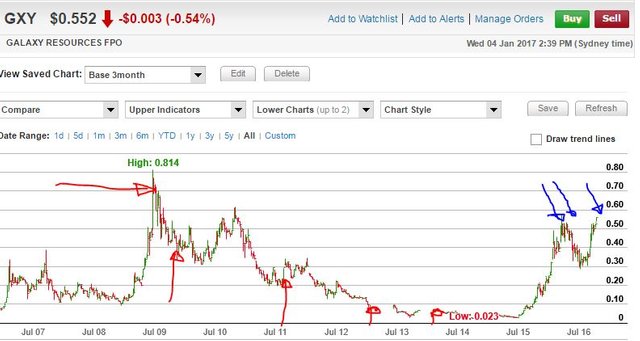
The turnaround has come - lithium price is up; lithium carbonate plant was sold to the Chinese joint venture partner and a partner was found to complete Mt Cattlin (and has since been merged into the company).
Part 2 My investment coach identified Lithium as a breakout candidate earlier this year. His suggested vehicle was an ETF that tracks Lithium called Global X Lithium ETF (LIT). I bought shares in two of my portfolios in late February 2016 on the breakout (because they had no Lithium exposure). This is a classic breakout investment - price has been driven down, shows a bottom and breaks out. It helps too that the Lithium price was starting to move. I like using ETF's as a way to start an investment as they offer a low cost way to enter and someone else does the work to choose the constituents. It works if a whole sector is going to make the breakout move.
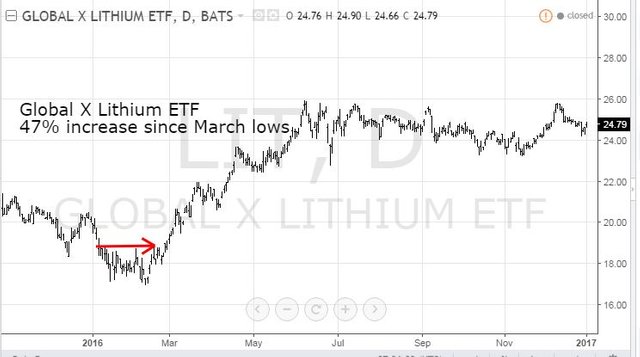
It was only really in June or July 2016, that the mainstream media found out about it. For example, here is an article in Fortune Magazine that asks the question about where price will go next.
http://fortune.com/2016/06/06/lithium-price-tesla-metal-future/
This article points out that lithium pricing is a complicated beast because there are many uses for lithium in different forms. The industry is also dominated by 4 large producers. Most lithium usage is in the form of lithium carbonate, for batteries. So most pricing for lithium is converted from lithium carbonate pricing. For a long time, price has been falling in inflation adjusted terms.
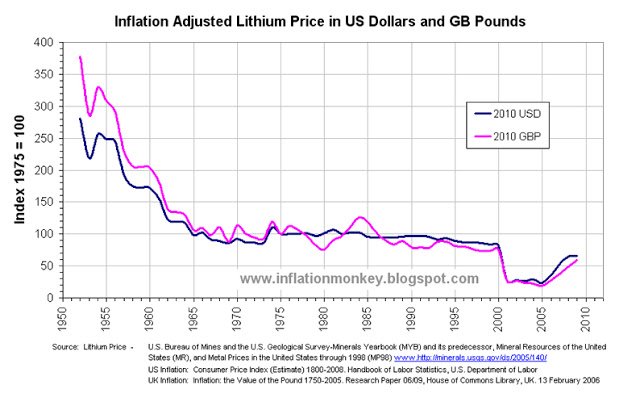
https://hotcopper.com.au/threads/lithium-price-chart.2705188/#.WGxsj9J95hE
It certainly was flattish when I bought Galaxy Resources. Had I done proper analysis of price fundamentals I would never had bought in October 2009. As it happens, the price stayed flat for the next 6 years and only started rising in mid 2015 with more dramatic price rises in 2016 - hence the steep rise in LIT share price.
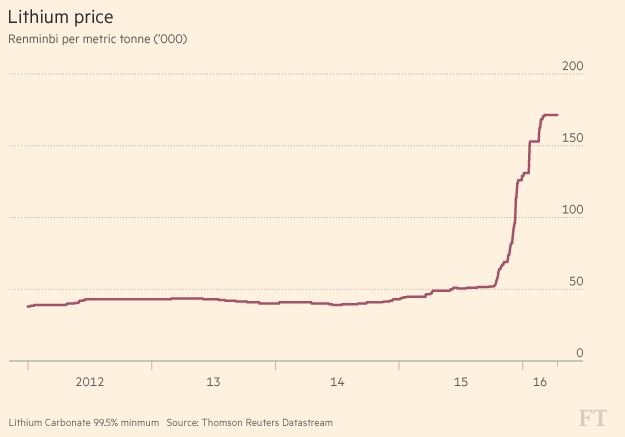
http://blogs.ft.com/ftdata/2016/04/14/lithium-price-on-the-rise/
Part 3: I was prompted by a post here on Steemit about Lithium the New Black Gold to dig a little deeper.
I did some digging into the components of the Lithium ETF to focus in on the companies that actually mine Lithium rather than companies that produce lithium-based products. Of the top 10 holdings in the fund, only 2 are pure play lithium miners and 1 has a range of other non-mining related activity (FMC Corporation - as it happens my fund manager had been invested in FMC Corporation from 2012 until 2014 - and we made a tidy profit).
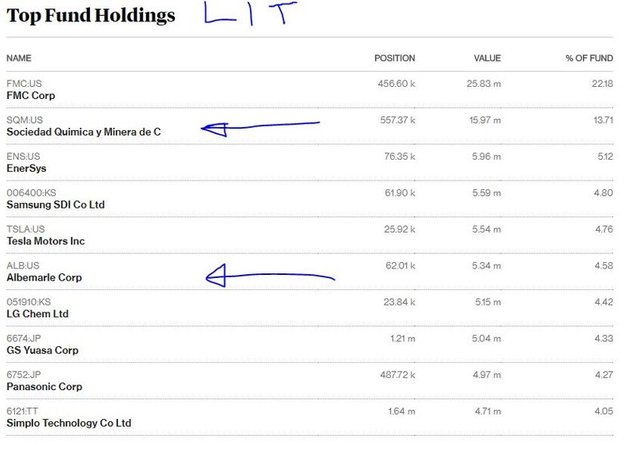
Based on this analysis, I bought shares in Sociedad Quirnica y Minera (SQM) which is the world's largest producer of lithium from salt brine - I liked this because they are big, have low cost of production, can ramp up capacity and they are not going to go out of business. You can read my analysis in the replies to the Steemit post.
Now there is one more dimension of resource investing to consider. What happens to an industry when there is a dramatic rise in price as we have seen in 2016?
The short answer is every man and his dog has dived into lithium exploration. I have many examples in my portfolio
- Mining Projects Group now Kairos Resources (KAI.AX) - Nickel explorer - buys Lithium tenements in the north of Australia
- International Goldfields (IGS.AX) - bought as a cannabis investment (was a gold
business) - starts exploring for Lithium on their gold tenements - Capital Mining (CMY.AX) - bought as a cannabis investment (was a gold business) - starts exploring for Lithium on their gold tenements and buys Lithium tenements in Western Australia
- Mustang Resources (MUS.AX) - bought as a ruby investment - starts exploring for lithium and buying lithium tenements in Mozambique
- Birimian Gold Limited (BGS.AX) - has gold and lithium tenements in Mali (Africa). I did buy this this as a lithium investment.
- De Grey Mining (DEG.AX) - bought as a gold mining investment - now searching for lithium on their gold tenements.
[Side note: Investing in junior resource mining companies carries substantial risk. Some will go out of business. Some will change the focus of what they do. All will ask investors for more capital. A lot of this capital raising will be for sophisticated investors only (so your share will get diluted) and the share price will collapse to the level raised at. They do not pay dividends until they go into production. To manage this, I invest small amounts in a range of candidate stocks and I keep back some cash to meet capital requests]
With all this investment in mining capacity there has to be an impact on price as new supply comes on line. If the growth in supply outstrips demand, price will collapse just as fast as it rose. One also has to consider the impact of rising interest rates on the ability to finance mine expansion. I did find this really interesting article which models the different supply scenarios for lithium. Here is a chart which shows 3 scenarios for lithium pricing.
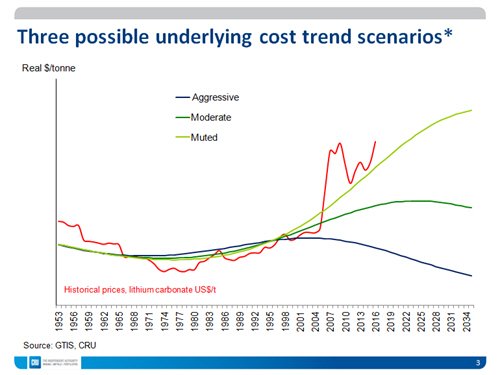
http://www.crugroup.com/about-cru/cruinsight/Lithium-The_Problem_With_Prices
One has to take a bit of a thumb in the air and decide which way to go. My read based on my Galaxy experience is that we are unlikely to see the bad scenario for some years yet. It has taken Galaxy 6 years to go from mine feasibility to first shipments (made last week) - every other hard rock miner will be about the same. If that is true, the model suggests there are still 2 to 3 years to run with no changes in demand. For me, I will hold my investments until such time as I see the asymmetry of the trade disappear. My sense is that the real kicker to price comes when an exploration company gets into development and production - the art is to pick likely survivors.
Why then did I sell my Galaxy Resources shares?
I just felt that they had made the transition into production and the kicker was no longer there. Maybe I got bored. I did feel better about price improvement potential from Birimian (BGS.AX). Unbeknownst to me at the time I set up the pending order for Galaxy, Birimian sold their business (announced on January 3) and the upside has now been capped. I am still holding a position in Galaxy Resources and in SQM. I also have the faint hope that one of the minnows that are trying to find lithium will be a winner (or they will go back to what they are good at and make money that way)
Is there still upside in Lithium? There is some time before capacity catches up to demand. There will be winners still. And if the pressure to build electric cars grows, the demand will grow even more dramatically. I have not done any digging into alternate ways of storing electricity - this is a risk factor.
Currency Trades
The USD is on the march. Sold EURUSD. Bought USDCHF. Bought USDJPY. Sold XAUUSD
All opportunities from Dollar strength as US Dollar reaches a 14 year high against a basket of currencies. Interest rates are rising in the US and the cash will flow back into USD.
Cautions: This is not financial advice. You need to consider your own financial position and take your own advice before you follow any of my ideas, some of which are quite advanced. I do participate in an investing group - some of the ideas flow from there.
Images: I own the rights to use and edit the Buy Sell image. Price chart images have been credited in the links below each chart. All other images are created using my various trading and charting platforms. They are all my own work
January 3, 2017
Nice, I dived into the lithium junior miners last year with a purchase of LIXXF.
I have ALB in my IRA at cost of low 50's/share and it has done wonderfully.
Cool. Looks like you got in at the bottom too (unless of course you were in way before - 2012 was the time before it was in the 50's). I had a quick look at ALB chart [note for other readers: Albemarle Corp is one of the large lithium miners].
It has nearly doubled since the early 2016 lows whereas LIT ETF has only gone up 47% . This stands out in the Buy:Sell chart - Buy ALB and Sell LIT
ALB outperformed LIT in 2013, then tracked together and raced away from late 2015. This is why I reduced exposure to the ETF and focused on the pure-play miners.
I purchased ALB in Feb of '16, so got a nice run up this year. With the increasing use of lithium, I felt that it was a good choice. I got LIXXF too as a junior, and it has had its ups and downs but I am up currently. With the juniors I figured I had a little bit of time to get onboard since many of them are years away from production. I would like to grab a few more companies here and there to see if I can find a homerun by around 2021 or so.
My trick for the juniors is to buy a whole bunch rather than trying to identify a winner - say $250 to $500 a pop. With low trading costs (say $1 per $250 trade) in US markets that is where I would lean. I am lazy and I am not good at being awake for US market open times - so I do Australian juniors too and trading costs are closer to $20 - so one has to buy lots of $1,000 or more.
Once one or two start to develop in the right direction, I add to those holdings and scale in that way.
That is exactly what I have been doing with junior gold miners. I just need to research which of the lithium ones are looking the most promising.